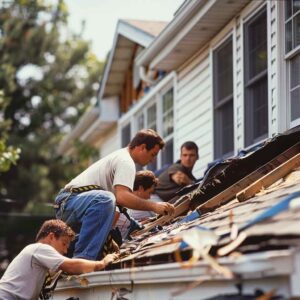Are you a homeowner in need of some essential roof maintenance tips? Look no further! In this article, our Gap roofing contractors will provide you with expert advice on how to keep your roof in top shape.
From inspecting your roof regularly to cleaning your gutters and downspouts, we’ve got you covered.
Learn about trimming overhanging branches, repairing damaged shingles or tiles, and ensuring proper attic ventilation. Follow these tips, and you’ll be well-equipped to maintain a sturdy and durable roof.
Tip 1: Regularly Inspect Your Roof
Performing routine roof inspections is crucial in maintaining the overall condition of your roof and preventing potential issues from escalating into costly repairs.
While you can inspect your roof yourself, hiring a professional for regular roof inspections offers several benefits.
Professional roof inspectors have the expertise and knowledge to identify even the smallest signs of damage that may go unnoticed to an untrained eye.
They can also provide recommendations on necessary repairs or maintenance to prolong the lifespan of your roof.
Additionally, it is equally important to keep your roof clean and free from debris.
Leaves, branches, and other debris can accumulate on your roof, causing blockages and water damage. Regularly removing debris will help maintain the integrity of your roof and prevent potential issues.
Tip 2: Clean Your Gutters and Downspouts Twice a Year
Regularly cleaning your gutters and downspouts is essential for maintaining the overall condition of your roof and preventing potential issues from arising.
Gutters and downspouts play an important role in diverting rainwater away from your roof and foundation. When they get clogged with leaves, debris, or dirt, they can no longer effectively carry water away, leading to water damage and even foundation issues.
By cleaning your gutters and downspouts at least twice a year, you can prevent water from pooling on your roof, which can lead to rotting, leaks, and other forms of water damage.
Additionally, clogged gutters can cause water to overflow and seep into your foundation, potentially causing cracks and structural problems.
To clean your gutters and downspouts, start by removing any debris by hand or using a trowel.
Then, flush them with water to ensure proper drainage. If you’re not comfortable doing it yourself, consider hiring a professional to ensure a thorough cleaning and to prevent any accidents.
Tip 3: Always Trim Overhanging Branches
Trim overhanging branches to prevent potential damage to your roof and ensure its longevity. Overhanging branches can pose significant risks to your roof, especially during storms or high winds. Here are some reasons why you should prioritize trimming those branches:
- Pruning hazards: Overgrown branches can become weak and brittle over time, posing a threat to your property. Falling branches can cause severe damage to your roof, leading to costly repairs or even roof replacement.
- Prevent roof damage: Branches that touch or scrape against your roof can cause wear and tear on the shingles or tiles. This can create openings for water to seep in, leading to leaks and structural damage.
We recommend hiring professional tree trimming services to ensure that the job is done safely and effectively. They have the expertise and equipment to handle the task, reducing the risk of accidents or further damage.
Tip 4: Consistently Check Your Shingles or Tiles for Signs of Damage
Checking your shingles or tiles for signs of damage can help prevent further issues and costly repairs down the line.
Damaged shingles or tiles can lead to leaks and water damage, compromising the structural integrity of your roof. It is important to address these issues promptly.
When it comes to repairing damaged shingles or tiles, you have two options: DIY or hiring a professional.
DIY repairs can save you money on labor costs, but they require a certain level of skill and expertise. You will need to have the necessary tools and materials, as well as knowledge of proper installation techniques.
On the other hand, hiring a professional ensures that the repairs are done correctly and efficiently. They have the experience and equipment to handle the job, reducing the risk of further damage.
Consider the scope of the damage and your own abilities before deciding whether to tackle the repairs yourself or hire a professional.
Keep in mind that roof repair costs can vary depending on the extent of the damage and the materials used.
If you are unsure, it is best to consult with a roofing professional who can provide an accurate assessment and recommendation.
Tip 5: Ensure That Your Attic Has Proper Attic Ventilation
Proper attic ventilation plays a crucial role in extending the lifespan of your roof and preventing potential problems. Here are three reasons why you should prioritize attic ventilation:
- Attic insulation: Proper ventilation helps to regulate the temperature in your attic, which in turn protects the efficiency of your insulation. Without proper ventilation, heat and moisture can build up in the attic, causing the insulation to become less effective over time.
- Moisture prevention: Adequate ventilation helps to prevent the accumulation of moisture in your attic. Excess moisture can lead to the growth of mold and mildew, which not only damages your roof but also poses health risks to you and your family.
- Roof longevity: By allowing air to circulate in your attic, proper ventilation helps to reduce the risk of roof damage caused by excessive heat and moisture. This, in turn, extends the lifespan of your roof and saves you from costly repairs or replacements.





